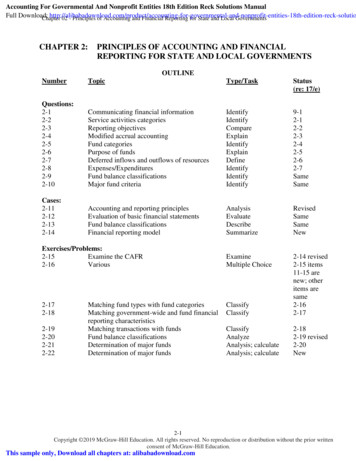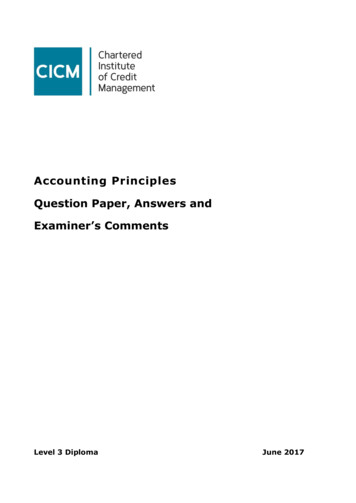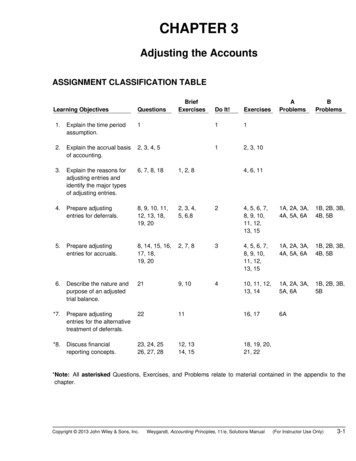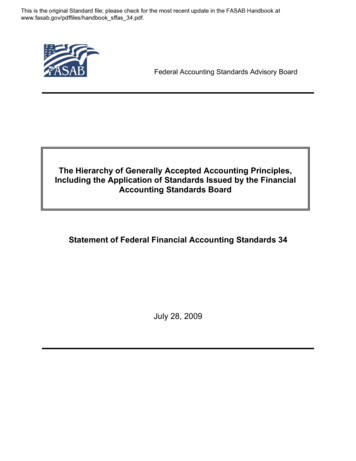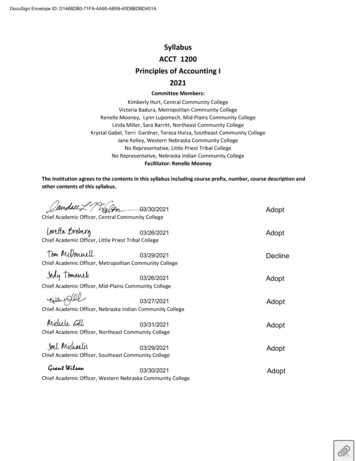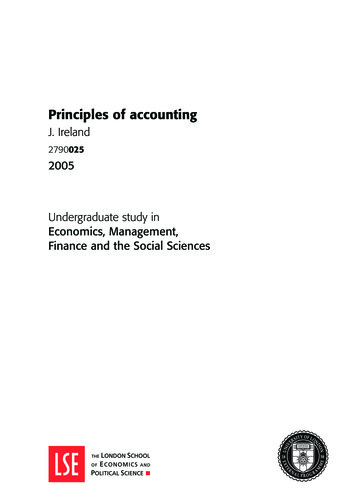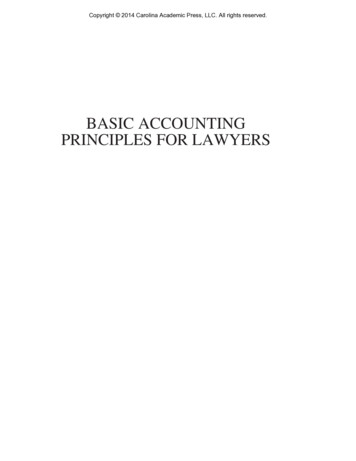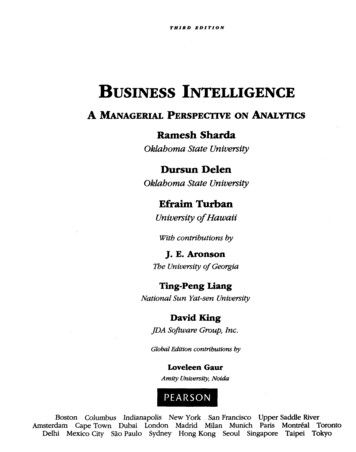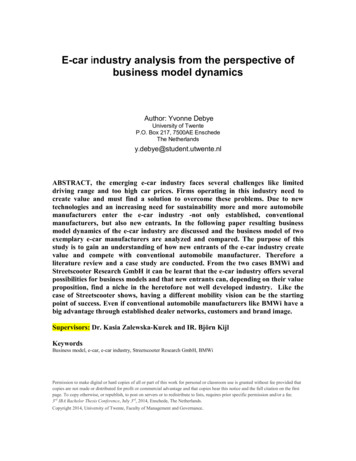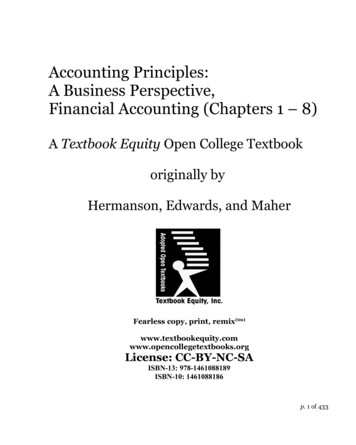
Transcription
Accounting Principles:A Business Perspective,Financial Accounting (Chapters 1 – 8)A Textbook Equity Open College Textbookoriginally byHermanson, Edwards, and MaherFearless copy, print, books.orgLicense: CC-BY-NC-SAISBN-13: 978-1461088189ISBN-10: 1461088186p. 1 of 433
About This PublicationSimply put, you may copy, print, redistribute, and re-purpose this textbook or parts of thistextbook provided that you give attribution (credit) to Textbook Equity, and provided thatany derivative work has the same Creative Commons license (CC-BY-NC-SA). That’s it.Textbook Equity, in turn, provides attribution, with thanks, to the Global Text Project, whoprovided the source textbook.Consistent with it’s strategic mission to provide free and low-cost textbooks, this is TextbookEquity’s derivative work based on “Accounting Principles: A Business Perspective, FirstGlobal Text Edition, Volume 1, Financial Accounting”, utilizing the permissions granted byit’s Creative Commons license. Global Text Project nor the original authors endorse or areresponsible in any way for this printing or it’s contents.Textbook Provenance (1998 - 2011)1998 EditionAccounting: A Business Perspective (Irwin/Mcgraw-Hill Series in Principles of Accounting)[Hardcover] Roger H. Hermanson (Author), James Don Edwards (Author), Michael W.Maher (Author) Eighth EditionHardcover: 944 pagesPublisher: Richard D Irwin; 7 Sub edition (April 1998)Language: EnglishISBN-10: 0075615851ISBN-13: 978-0075615859Product Dimensions: 11.1 x 8.7 x 1.8 inchesCurrent Hardbound Price 140.00 (Amazon.com)2010 Editions (http://globaltext.terry.uga.edu/books/)Global Text Project Conversion to Creative Commons License CC-BY“Accounting Principles: A Business Perspective First Global Text Edition, Volume 1 FinancialAccounting”, Revision Editor: Donald J. McCubbrey, PhD.PDF Version, 817 pages, Free Download“Accounting Principles: A Business Perspective First Global Text Edition, Volume 2Managerial Accounting”, Revision Editor: Donald J. McCubbrey, PhD.PDF Version Volume 2, 262 pages, Free Downloadp. 2 of 433
2011 Editions (http://opencollegetextbooks.org)Textbook Equity publishes this soft cover version using a the CC-BY-NC-SA license. Theydivided Volume 1 into two sections to fit paperback publishing requirements and made otherformatting changes. No content changes were made to Global Text’s version. Versionsavailable at the Open College Textbook repository: PDF Version, Section 1 of Volume 1 (Chapters 1 – 8), 436 pages, Free Download Textbook Equity Paperback, Volume 1 Financial Accounting (Chapters 1 – 8), 436 pages, ListPrice 19.95 PDF Version, Volume 1 Financial Accounting (Chapters 9 – 18), Free Download Textbook Equity Paperback, Volume 1 Financial Accounting (Chapters 9 – 18), List Price 19.95 PDF Version Volume 2, (Chapters 19 – 26), Free Download Textbook Equity Paperback, Volume 2 (Chapters 19 – 24), List Price 19.95For original author information and acknowledgments see opencollegetextbooks.orgp. 3 of 433
Preface from the eight edition:Philosophy and purposeImagine that you have graduated from college without taking an accounting course. You areemployed by a company as a sales person, and you eventually become the sales manager of a territory.While attending a sales managers' meeting, financial results are reviewed by the Vice President of Salesand terms such as gross margin percentage, cash flows from operating activities, and LIFO inventorymethods are being discussed. The Vice President eventually asks you to discuss these topics as theyrelate to your territory. You try to do so, but it is obvious to everyone in the meeting that you do notknow what you are talking about.Accounting principles courses teach you the "language of business" so you understand terms andconcepts used in business decisions. If you understand how accounting information is prepared, youwill be in an even stronger position when faced with a management decision based on accountinginformation.The importance of transactions analysis and proper recording of transactions has clearly beendemonstrated in some of the recent business failures that have been reported in the press. If thefinancial statements of an enterprise are to properly represent the results of operations and thefinancial condition of the company, the transactions must be analyzed and recorded in the accountsfollowing generally accepted accounting principles. The debits and credits are important not only toaccounting majors but also to those entering or engaged in a business career to become managersbecause the ultimate effects of these journal entries are reflected in the financial statements. Ifexpenses are reported as assets, liabilities and their related expenses are omitted from the financialstatements, or reported revenues are recorded prematurely or do not really exist, the financialstatements are misleading. The financial statements are only useful and meaningful if they are fair andclearly represent the business events of the company.We wrote this text to give you an understanding of how to use accounting information to analyzebusiness performance and make business decisions. The text takes a business perspective. We use theannual reports of real companies to illustrate many of the accounting concepts. You are familiar withmany of the companies we use, such as The Limited, The Home Depot, and Coca-Cola Company.Gaining an understanding of accounting terminology and concepts, however, is not enough toensure your success. You also need to be able to find information on the Internet, analyze variousp. 4 of 433
business situations, work effectively as a member of a team, and communicate your ideas clearly. Thistext was developed to help you develop these skills.Curriculum concernsSignificant changes have been recommended for accounting education. Some parties haveexpressed concern that recent accounting graduates do not possess the necessary set of skills tosucceed in an accounting career. The typical accounting graduate seems unable to successfully dealwith complex and unstructured "real world" accounting problems and generally lacks communicationand interpersonal skills. One recommendation is the greater use of active learning techniques in a reenergized classroom environment. The traditional lecture and structured problem solving methodapproach would be supplemented or replaced with a more informal classroom setting dealing withcases, simulations, and group projects. Both inside and outside the classroom, there would be two-waycommunication between (1) professor and student and (2) student and student. Study groups would beformed so that students could tutor other students. The purposes of these recommendations includeenhancing students' critical thinking skills, written and oral communication skills, and interpersonalskills.One of the most important benefits you can obtain from a college education is that you "learn howto learn". The concept that you gain all of your learning in school and then spend the rest of your lifeapplying that knowledge is not valid. Change is occurring at an increasingly rapid pace. You willprobably hold many different jobs during your career, and you will probably work for many differentcompanies. Much of the information you learn in college will be obsolete in just a few years. Therefore,you will be expected to engage in life-long learning. Memorizing is much less important than learninghow to think critically.With this changing environment in mind, we have developed a text that will lend itself to developingthe skills that will lead to success in your future career in business. The section at the end of eachchapter titled, "Beyond the numbers—Critical thinking", provides the opportunity for you to addressunstructured case situations, the analysis of real companies' financial situations, ethics cases, and teamprojects. Each chapter also includes one or two Internet projects in the section titled "Using theInternet—A view of the real world". For many of these items, you will use written and oralcommunication skills in presenting your results.p. 5 of 433
Objectives and overall approach of the eightheditionThe Accounting Education Change Commission (AECC) made specific recommendations regardingteaching materials and methods used in the first-year accounting course. As a result, significantchanges have taken place in that course at many universities. The AECC states:The first course in accounting can significantly benefit those who enter business,government, and other organizations, where decision-makers use accountinginformation. These individuals will be better prepared for their responsibilities if theyunderstand the role of accounting information in decision-making by managers,investors, government regulators, and others. All organizations have accountabilityresponsibilities to their constituents, and accounting, properly used, is a powerful tool increating information to improve the decisions that affect those constituents. 1One of the purposes of the first course should be to recruit accounting majors. To help accomplishthis, the text has a section preceding each chapter entitled, "Careers in accounting".We retained a solid coverage of accounting that serves business students well regardless of themajors they select. Those who choose not to major in accounting, which is a majority of those takingthis course, will become better users of accounting information because they will know somethingabout the preparation of that information.Approach and organizationBusiness emphasisWithout actual business experience, business students sometimes lack a frame of reference inattempting to apply accounting concepts to business transactions. We seek to involve the businessstudent more in real world business applications as we introduce and explain the subject matter. "An accounting perspective: Business insight" boxes throughout the text provideexamples of how companies featured in text examples use accounting information every day, orthey provide other useful information.1 Accounting Education Change Commission, Position Statement No. Two, “The First Course inAccount” (Torrance, CA, June 1992), pp. 1-2.p. 6 of 433
"Accounting perspective: Uses of technology" boxes throughout the text demonstratehow technology has affected the way accounting information is prepared, manipulated, andaccessed. Some chapters contain "A broader perspective". These situations, taken from annual reportsof real companies and from articles in current business periodicals such as Accounting Today, andManagement Accounting, relate to subject matter discussed in that chapter or present otheruseful information. These real world examples demonstrate the business relevance of accounting. Real world questions and real world business decision cases are included in almost everychapter. The annual report appendix included with this text contains significant portions of the annualreport of The Limited, Inc. Many of the real world questions and business decision cases are basedon this annual report. Numerous illustrations adapted from Accounting Trends & Techniques show the frequency ofuse in business of various accounting techniques. Placed throughout the text, these illustrationsgive students real world data to consider while learning about different accounting techniques. Throughout the text we have included numerous references to the annual reports of manycompanies. Chapters 1-16 contain a section entitled, "Analyzing and using the financial results". This sectiondiscusses and illustrates a ratio or other analysis technique that pertains to the content of thechapter. For instance, this section in Chapter 4 discusses the current ratio as it relates to aclassified balance sheet. Some of the chapters contain end-of-chapter questions, exercises, or business decision cases thatrequire the student to refer to the Annual report appendix and answer certain questions. As statedearlier, this appendix is included with the text and contains the significant portions of the annualreport of The Limited, Inc. Each chapter contains a section entitled, "Beyond the numbers—Critical thinking". This sectioncontains business decision cases, annual report analysis problems, writing assignments based onthe Ethical perspective and Broader perspective boxes, group projects, and Internet projects.p. 7 of 433
PedagogyStudents often come into accounting principles courses feeling anxious about learning the subjectmatter. Recognizing this apprehension, we studied ways to make learning easier and came up withsome helpful ideas on how to make this edition work even better for students. Improvements in the text's content reflect feedback from adopters, suggestions by reviewers,and a serious study of the learning process itself by the authors and editors. New subject matter isintroduced only after the stage has been set by transitional paragraphs between topic headings.These paragraphs provide students with the reasons for proceeding to the new material andexplain the progression of topics within the chapter. The Introduction contains a section entitled "How to study the chapters in this text", whichshould be very helpful to students. Each chapter has an "Understanding the learning objectives" section. These "summaries" enablethe student to determine how well the learning objectives were accomplished. We were the firstauthors (1974) to ever include Learning objectives in an accounting text. These objectives havebeen included at the beginning of the chapter, as marginal notes within the chapter, at the end ofthe chapter, and in supplements such as the Test bank, Instructors' resource guide, Computerizedtest bank, and Study guide. The objectives are also indicated for each exercise and problem. Demonstration problems and solutions are included for each chapter, and a different oneappears for each chapter in the Study guide. These demonstration problems help students toassess their own progress by showing them how problems that focus on the topic(s) covered in thechapter are worked before students do assigned homework problems. Key terms are printed for emphasis. End-of-chapter glossaries contain the definition. Each chapter includes a "Self-test" consisting of true-false and multiple-choice questions. Theanswers and explanations appear at the end of the chapter. These self-tests are designed todetermine whether the student has learned the essential information in each chapter. In the margin beside each exercise and problem, we have included a description of therequirements and the related Learning objective(s). These descriptions let students know whatthey are expected to do in the problem. Throughout the text we use examples taken from everyday life to relate an accounting conceptbeing introduced or discussed to students' experiences.p. 8 of 433
EthicsThere is no better time to emphasize high ethical standards to students. This text includes manyitems throughout the text entitled, "An ethical perspective". These items present situations in whichstudents are likely to find themselves throughout their careers. They range from resisting pressure by asuperior or a client to do the wrong thing to deciding between alternative corporate behaviors that haveenvironmental and profit consequences.End-of-chapter materialsDescribing teaching methods, the AECC stated, "Teachers.should place a priority on theirinteraction with students and on interaction among students. Students' involvement should bepromoted by methods such as cases, simulations, and group projects." 2 A section entitled "Beyond thenumbers—Critical thinking" at the end of every chapter is designed to implement theserecommendations. Business decision cases require critical thinking in complex situations often basedon real companies. The Annual report analysis section requires analyzing annual reports andinterpreting the results in writing. The Ethics cases require students to respond in writing to situationsthey are likely to encounter in their careers. These cases do not necessarily have one right answer. TheGroup projects for each chapter teach students how to work effectively in teams, a skill that wasstressed by the AECC and is becoming increasingly necessary for success in business. The Internetprojects teach students how to retrieve useful information from the Internet.A team approach can also be introduced in the classroom using the regular exercises and problemsin the text. Teams can be assigned the task of presenting their solutions to exercises or problems to therest of the class. Using this team approach in class can help re-energize the classroom by creating anactive, informal environment in which students learn from each other. (Two additional group projectsare described in the Instructor's resource guide. These projects are designed to be used throughout thesemester or quarter.)We have included a vast amount of other resource materials for each chapter within the text fromwhich the instructor may draw: (1) one of the largest selections of end-of-chapter questions, exercises,and problems available; (2) several comprehensive review problems that allow students to review allmajor concepts covered to that point; and (3) from one to three business decision cases per chapter.Other key features regarding end-of-chapter material follow.2Ibid, p.2.p. 9 of 433
A uniform chart of accounts appears in a separate file you can download. This uniform chart ofaccounts is used consistently throughout the first 11 chapters. We believe students will benefitfrom using the same chart of accounts for all homework problems in those chapters. A comprehensive review problem at the end of Chapter 4 serves as a mini practice set to test allmaterial covered to that point. Another comprehensive problem at the end of Chapter 19 reviewsthe material covered in Chapters 18 and 19. Two comprehensive budgeting problems are alsoincluded as business decision cases at the end of Chapter 23. Some of the end-of-chapter problem materials (questions, exercises, problems, business decisioncases, other "Beyond the numbers" items, and comprehensive review problems) have beenupdated. Each exercise and problem is identified with the learning objective(s) to which it relates. All end-of-chapter exercises and problems have been traced back to the chapters to ensure thatnothing is asked of a student that does not appear in the book. This feature was a strength ofprevious editions, ensuring that instructors could confidently assign problems without having tocheck for applicability. Also, we took notes while teaching from the text and clarified problem andexercise instructions that seemed confusing to our students.p. 10 of 433
Table of Contents1 The Accounting Environment.141.1 Learning objectives.141.2 Accounting Defined.151.3 Employment opportunities in accounting.171.4 Financial accounting versus managerial accounting.211.5 Development of financial accounting standards.231.6 Ethical behavior of accountants.251.7 Critical thinking and communication skills.261.8 Internet skills.271.9 How to study the chapters in this text.272 Accounting and its use in business decisions.302.1 Learning objectives.302.2 A career as an entrepreneur.302.3 Forms of business organizations.312.4 Types of activities performed by business organizations.332.5 Financial statements of business organizations.342.6 The financial accounting process.392.7 Underlying assumptions or concepts .402.8 Transactions affecting only the balance sheet .412.9 Transactions affecting the income statement and/or balance sheet .452.10 Summary of balance sheet and income statement transactions.482.11 Dividends paid to owners (stockholders).492.12 Analyzing and using the financial results—the equity ratio.522.13 Understanding the learning objectives.532.14 Appendix: A comparison of corporate accounting with accounting for a soleproprietorship and a partnership.542.15 Demonstration problem.552.16 Solution to demonstration problem.572.17 Key terms.582.18 Self-test.603 Recording business transactions.773.1 Learning objectives.773.2 Salary potential of accountants.773.3 The account and rules of debit and credit.793.4 Recording changes in assets, liabilities, and stockholders' equity.81p. 11 of 433
3.5 The accounting cycle.863.6 The journal.873.7 The ledger. 903.8 The accounting process in operation.913.9 The use of ledger accounts.1053.10 Analyzing and using the financial results— Horizontal and vertical analyses.1153.11 Key terms.1233.12 Self-test.1244 Adjustments for financial reporting.1444.1 Learning objectives.1444.2 A career as a tax specialist.1444.3 Cash versus accrual basis accounting.1454.4 The need for adjusting entries.1474.5 Classes and types of adjusting entries.1494.6 Adjustments for deferred items.1514.7 Adjustments for accrued items.1624.8 Effects of failing to prepare adjusting entries.1664.9 Analyzing and using the financial results—trend percentages.1664.10 Understanding the learning objectives.1675 Completing the accounting cycle.1905.1 Learning objectives.1905.2 A career in information systems.1905.3 The accounting cycle summarized.1915.4 The work sheet.1915.5 Preparing financial statements from the work sheet.1995.6 Journalizing adjusting entries.2005.7 The closing process.2015.8 Accounting systems: From manual to computerized.2105.9 A classified balance sheet.2165.10 Analyzing and using the financial results — the current ratio.2235.11 Understanding the learning objectives.2246 Accounting theory.2546.1 Learning objectives.2546.2 A career as an accounting professor.2546.3 Traditional accounting theory.2556.4 Underlying assumptions or concepts.2566.5 Other basic concepts.2586.6 The measurement process in accounting.2596.7 The major principles.2606.8 Modifying conventions (or constraints).2686.9 The financial accounting standards board's conceptual framework project.270p. 12 of 433
6.10 Objectives of financial reporting.2716.11 Qualitative characteristics.2736.12 The basic elements of financial statements.2776.13 Recognition and measurement in financial statements.2796.14 Summary of significant accounting policies.2796.15 Significant accounting policies.2806.16 Understanding the learning objectives.2837 Introduction to inventories and the classified income statement.3037.1 Learning objective .3037.2 A career as a CEO.3037.3 Two income statements compared— Service company and merchandising company. 3057.4 Sales revenues.3057.5 Cost of goods sold.3137.6 Classified income statement.3247.7 Analyzing and using the financial results—Gross margin percentage.3297.8 Understanding the learning objectives.3297.9 Appendix: The work sheet for a merchandising company.
Global Text Edition, . responsible in any way for this printing or it’s contents. Textbook Provenance (1998 - 2011) 1998 Edition Accounting: A Business Perspective (Irwin/Mcgraw-Hill Series in Principles of Accounting) . with complex and unstructured "real world" accounting pr
